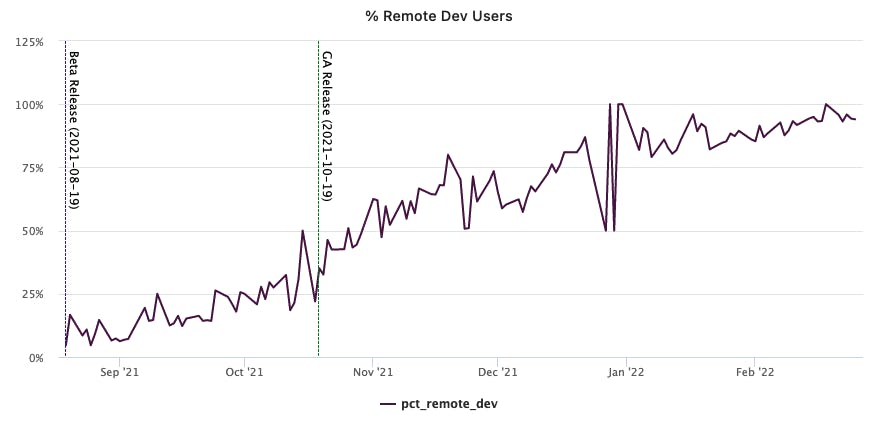In this article:
- Remote development trend growing due to cloud-native services' popularity and COVID-19 acceleration.
- Basics of remote development involve accessing IDEs on remote servers or cloud platforms.
- Advantages include flexibility, security, simplified zero-trust, environment consistency, developer self-service, and faster onboarding.
- Companies like Slack and Uber have seen significant productivity gains with remote development.
- Local development faces challenges with consistency, limited resources, security, and remote work demands.
- Remote development expected to become standard, but local development may still have niche uses.
- Tools like Bunnyshell simplify the adoption of cloud development environments for remote work.
The trend towards remote development has been growing, driven by the popularity of cloud-native services that cannot be emulated locally. COVID-19 has rapidly accelerated this trend, forcing companies to shift to remote work and confront the limitations of traditional network security.
As a result, software development teams had to adapt quickly to maintain productivity and security. The growing adoption of cloud computing and data storage indicates that remote cloud development will play a significant role in future software development.
The pandemic has underlined the shift to remote work, and many workers will continue to work remotely or in a hybrid environment. Developers are suited for this change, with their daily work often involving accessing remote servers.
The basics of remote development
Remote development refers to the setup where developers access and run their integrated development environments (IDEs) on remote servers or cloud-based platforms rather than on their local machines.
It refers to the practice of using cloud development environments to write, run, and debug code, allowing developers to access their development environment from anywhere with an internet connection and work remotely.
Remote Development is here to stay
The trend toward cloud development environments has increased due to several key factors.
Firstly, the growing popularity of cloud-native services and the increasing adoption of cloud computing has made it easier for developers to access their development environment from anywhere with an internet connection. This has made remote work more feasible and has led to more developers using remote development environments.
Secondly, the COVID-19 pandemic has accelerated the trend towards remote work, as companies and developers realized the limitations of their traditional approach to network security and had to quickly find ways to ensure employee productivity while working from home. This has further emphasized the importance of remote development environments in the future of software development.
Thirdly, cloud-based remote development offers increased accessibility, better team collaboration, and easy scaling of resources. With cloud resources, developers can build, deploy, and run apps without expensive hardware.
Additionally, remote development combined with on-demand staging environments and automatic preview environments - a complete Environments-as-a-Service platform, has been shown to increase development velocity by 25%, resulting in an 8-hour weekly productivity gain per engineer.
Big tech companies like Uber, Slack, and Shopify have already adopted remote development and are reaping the benefits of cloud-based development environments.
This trend towards remote and cloud development environments is expected to continue as more and more companies adopt remote work policies and embrace the benefits of cloud development environments.
Advantages of Remote Development
Remote development has gained popularity in recent years due to the numerous benefits it offers. Using cloud-based development environments, developers can connect from anywhere and use any device to access their workspaces, making it a flexible and cost-effective solution for companies.
- Code from anywhere on any device. With developer workspaces hosted in the cloud, teams can work securely from any location with any device, regardless of their physical location, reducing costs for companies and enabling "bring your own device."
- Secure Source Code. The source code never leaves the security of the company's cloud infrastructure and remains in the Git repositories and Kubernetes cluster where the developer workspaces reside, avoiding the risk of source code exposure on developers' laptops.
- Simplified zero-trust security. Cloud-based development environments can simplify network security and make it easier for organizations to maintain a secure remote work environment.
- Environment consistency. With cloud-based development, teams no longer have to worry about "it works on my machine" issues as the development environments are consistent and easily replicable.
- Developer Self-service. With standardized and replicable cloud development environments, developers have more control and autonomy over their processes, reducing the need for assistance from DevOps teams.
- New developers fast onboarding. With cloud development environments, new engineers can be up and running in just hours, not weeks, with minimal setup and without the need for extensive application knowledge.
Developers love remote development
At first, many companies faced some resistance from their developers when implementing remote development. However, as they started using it, they quickly realized the benefits and became fans of the new way of working.
Slack and Uber are two companies that have seen great success with the adoption of remote development. At Slack, the process of adopting remote development was smooth and successful, with over 90% of engineers completely switching to the remote development workflow just a few months after its general release. The response from engineers was overwhelmingly positive, with many citing improvements in productivity and efficiency.
Similarly, Uber has seen significant benefits from adopting remote development, with developers reporting faster build times and improved efficiency. Most Uber developers have responded positively to the change, with many loving the new remote development setup.
These experiences show that remote development can significantly improve developers' productivity and efficiency, and companies are taking note. As more companies adopt remote development, it will likely become the standard way of working for developers soon.

Remote Development adoption at Slack
Is Local Development obsolete?
While local development has been the traditional method for software development, it has its own set of challenges.
One of the major issues is the need to maintain consistent development environments across multiple machines and users. This can be difficult to achieve, as different engineers may have different configurations and setups, leading to compatibility and consistency issues.
Additionally, developers are often limited by their personal machines' processing power and memory, which can slow down the development process.
Local development can be less secure, as the source code is stored on individual laptops and other physical devices, increasing the risk of data loss or theft.
The rise of remote work has made local development increasingly difficult, as developers are no longer always near the resources and hardware they need to work effectively. The shift towards remote work has made local development nearly obsolete, as cloud-based environments have become the preferred solution for many organizations.
Will remote development completely replace local development?
In the coming years, remote development is expected to become the norm for many organizations. With the ability to access cloud-based development environments from anywhere, remote work has become more practical and efficient.
Most probably, local development will still have its place, particularly for solo developers who may prefer the convenience and control of working on their own machines.
It's safe to say that remote development will become the standard in the near future, with local development being a less frequent option, mainly for solo developers. This shift is driven by the many advantages that remote development offers, such as the ability to work from anywhere and the ease of collaboration with remote teams.
While some developers may still prefer a more personal and hands-on approach through local development, the growing trend towards remote work will likely drive increased adoption of cloud-based development environments.
Is there an easy way to get started with Cloud Development Environments?
Adopting remote development is becoming more widespread due to its numerous benefits. The good news is that getting started is now easier than ever with dedicated tools for remote development or Environment-as-a-Service solutions.
One solution to consider is Bunnyshell. With Bunnyshell, you can instantly spin up development and staging production-like environments for any task on Kubernetes and code remotely without the hassle of setting up and waiting for busy DevOps teams to respond.
If you're ready to start with remote development, Bunnyshell is an excellent option to consider.
